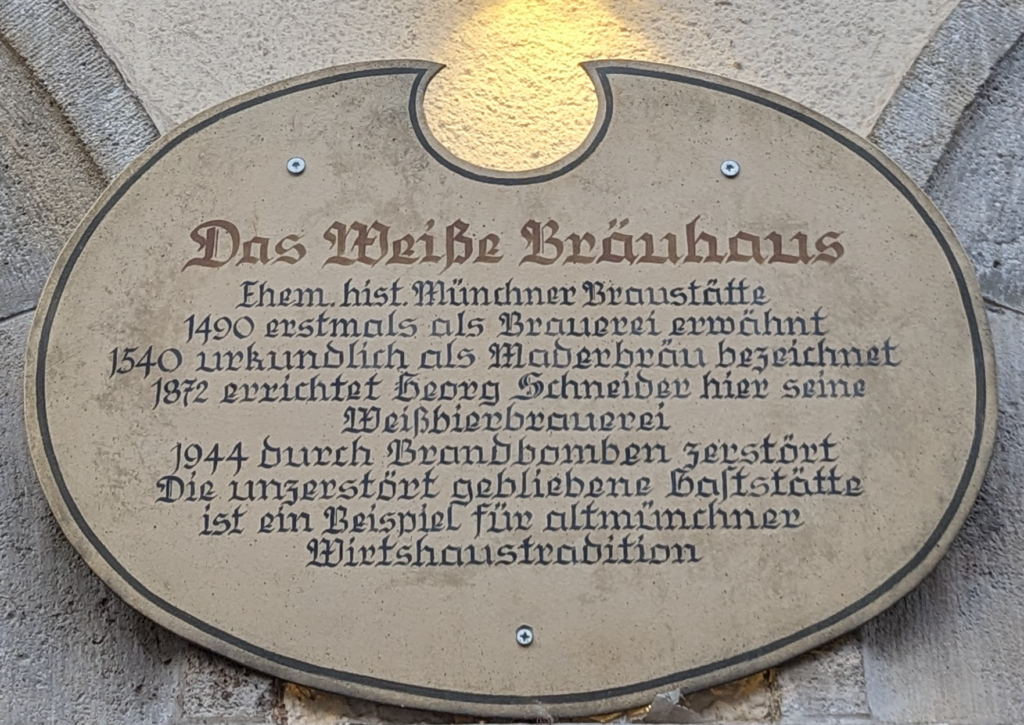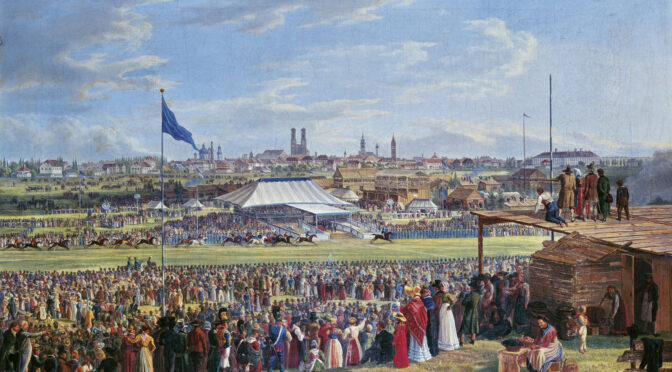Bavarikon, Bavaria’s internal portal to present treasures, art and other things from its archives, libraries and museums, is an incredibly valuable platform, as you can find all kinds of random bits and pieces related to Bavaria in some shape or some. They of course have lots of digitalized material about Oktoberfest, like this map of Oktoberfest at Theresienwiese from 1843:

This is great, because not only does it give us insight into the overall setup (basically, the horse racing course was on the outside of the field, while in the middle, most of the stands could be found, with more stands to be found on the hill on the Western side of Theresenwiese, just north of the Bavaria statue.
Of course, the King had his own tent, with the agricultural exhibition placed near it. On the South side, the shooting range was located, while in the center, the most was going on: lots of places serving beer, coffee, wine, punch, cold and hot food, or pastries, but there were also attractions like a carousel and crossbow shooting, and the Glückshafen, a lottery with the purpose that its profit be used to support the city’s poor. That attraction still exists today, and is the oldest operation at the Oktoberfest.
Most importantly though, we also learn which breweries’ beers were served in 1843:
- Singelspieler
- Mader
- Oberkandler
- Knor[r]
- Hacker
- Löwenbräu
- Pschor[r]
- Unterkandler
- Tölzer (from Tölz; nowadays Bad Tölz)
- Hesselloher (probably referring to the brewery in Großhesselohe in Pullach, just South of Munich)
Some of these breweries resp. brands are still around, like Hacker and Pschorr in the Hacker-Pschorr brand, and Löwenbräu, while others are less known: Maderbräu is probably best known these day through Maderbräustraße, the little street next to Weißes Brauhaus in Munich: when Georg Schneider had to move out of the old Weißes Brauhaus (roughly where Hofbräuhaus is located nowadays), he managed to buy the defunct Maderbräu brewery building and relocate his brewery there. Only the street name and a sign on the wall of Weißes Brauhaus are reminders of this old Munich brewery.

The other Munich breweries in this list are attested through an old map from the 1830s of Munich breweries: Knorrbräu on Briennerstraße, Oberkandler and Unterkandler, both on Neuhauser Straße, and Singelspieler on Sendlinger Straße. Even beer from further away was brought to Theresienwiese and served there, such as from Tölz, South of Munich, and Hesselloher Bier, which was likely from the brewery in Großhesselohe in Pullach just outside Munich, but that’s not entirely clear from the source.
From an 1824 painting by Heinrich Adam, we can also get a rough idea how serving beer used to be organised like, on a much smaller scale than nowadays, from wooden shacks like this one:

(header image by Heinrich Adam, 1824, licensed under CC-BY-SA 4.0. source)


I think a great idea for a new book would be a history of the beers and their breweries that took part at the Oktoberfest over its history. Since many of the breweries no longer exist, it would be interesting to see what became of them.
That certainly sounds like an exciting, but it probably depends on what sources still exist from all the old 19th century Munich breweries, and if so, to what extent they’re publicly accessible.